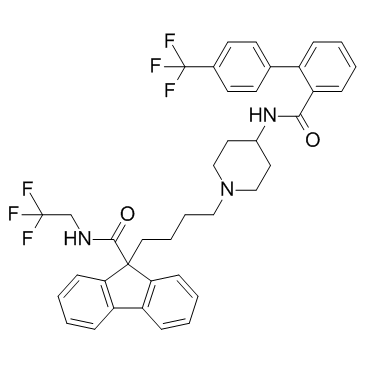182431-12-5
| Name | lomitapide |
|---|---|
| Synonyms |
Lomitapide
N-(2,2,2-Trifluoroethyl)-9-{4-[4-({[4'-(trifluoromethyl)-2-biphenylyl]carbonyl}amino)-1-piperidinyl]butyl}-9H-fluorene-9-carboxamide AEGR 733 UNII-82KUB0583F Juxtapid N-(2,2,2-trifluoroethyl)-9-{4-[4-({[4'-(trifluoromethyl)biphenyl-2-yl]carbonyl}amino)piperidin-1-yl]butyl}-9H-fluorene-9-carboxamide N-(2,2,2-trifluoroethyl)-9-[4-[4-[[2-[4-(trifluoromethyl)phenyl]benzoyl]amino]piperidin-1-yl]butyl]fluorene-9-carboxamide 9H-Fluorene-9-carboxamide, N-(2,2,2-trifluoroethyl)-9-[4-[4-[[[4'-(trifluoromethyl)[1,1'-biphenyl]-2-yl]carbonyl]amino]-1-piperidinyl]butyl]- |
| Description | Lomitapide (AEGR-733; BMS-201038) is a potent inhibitor of microsomal triglyceride-transfer protein (MTP) with an IC50 of 8 nM in vitro. |
|---|---|
| Related Catalog | |
| Target |
IC50: 8 nM (MTP)[1] |
| In Vitro | Lomitapide is an oral microsomal triglyceride transfer protein (MTP) inhibitor indicated for the treatment of patients with HoFH, a rare form of hypercholesterolemia that can lead to premature atherosclerotic disease. Lomitapide undergoes hepatic metabolism via cytochrome P-450 (CYP) isoenzyme 3A4 and interacts with CYP3A4 substrates including atorvastatin and simvastatin[2]. |
| In Vivo | The use of lomitapide alone or in combination with other lipid-lowering modalities reduces plasma concentrations of low density lipoprotein cholesterol (LDL-C) by a mean of more than 50%. Lomitapide is associated with significant gastrointestinal adverse effects and increases in hepatic fat levels. The bioavailability of the 50-mg lomitapide capsule is 7.1%. The mean half-life of lomitapide is 39.7 hours[2]. Single-dose administration of lomitapide is shown to reduce serum triglycerides by 35% and 47% at 0.3- and 1-mg/kg doses, respectively. Multiple-dose treatment with lomitapide also results in dose dependent decrease in triglycerides (71%–87%), nonesterified fattyacids(33%–40%), and LDL-C(26-29%)[3]. |
| Animal Admin | Rats: BMS-201038 is formulated in 0.1% hydroxyl ethyl cellulose and 0.5% Tween 80 in deionized water. Rats in the control group are administered vehicle (2 mL/kg) p.o. Fasted rats are administered 0.3 and 1 mg/kg, p.o., BMS-201038, followed 1 h later by 250 mg/kg, i.v., Triton WR1339. Blood samples are obtained from rats up to 240 min after Triton WR1339 injection to estimate serum triglyceride concentrations. For evaluation of post-prandial lipaemia, fasted rats are administered 0.3 and 1 mg/kg, p.o., BMS-201038, followed 1 h later by a corn oil bolus (6 mL/kg) by oral gavage. Blood samples are again collected up to 1440 min after corn oil administration for the estimation of serum triglyceride concentrations[3]. |
| References |
| Density | 1.3±0.1 g/cm3 |
|---|---|
| Boiling Point | 778.2±60.0 °C at 760 mmHg |
| Molecular Formula | C39H37F6N3O2 |
| Molecular Weight | 693.720 |
| Flash Point | 424.4±32.9 °C |
| Exact Mass | 693.278992 |
| PSA | 68.42000 |
| LogP | 7.78 |
| Vapour Pressure | 0.0±2.7 mmHg at 25°C |
| Index of Refraction | 1.606 |
| Storage condition | -20°C |
| Hazard Codes | T+ |
|---|---|
| RIDADR | NONH for all modes of transport |
